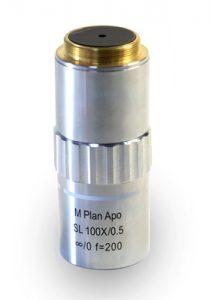Microscopic Objectives

Microscopic Objective lenses has four objectives. The objectives are- Scanning Objectives, Low Power Objective, High Power Objective, and the Immersion Objective.
Let's discuss them:
The Scanning Objectives is the shortest and is useful for getting an overview of the slide.
The Low Power Objective is next to the shortest objective, and is the most useful. It can be located with the 100X magnification. It also is safe to use, because it cannot be lowered to the point of contacting- to break a slide.
The High Performance Objective observes fine details like the Striations, the Haversian System, and the cells in the eye.
The oil Immersion Objective, known as the longest, is used for observing the cells, and the cells, involved in spermatogenesis. It has to have formulated oil, that create a bridge between the tip and the cover slip of the objective.
When using the objectives, make sure the specimen is under 40x objective. You will then place a small drop into place. Use the fine adjustable lens, to bring the specimen into focus. Make sure the oil does not contact other objectives.
There is also a MV-and M- microscopic objective that is economical and is standard. It is available in a range of powers from 5x to 60x. There is also accessories like, optical post, optical mounts, clamp on fork and pedestals that makes focusing more easier.
Microscopic Objectives are ideal for collimating and focusing beam in the visible applications, involved in focus laser beam. They are broadband AR coated and designed for diffraction limited performance across the entire lens spectrum. They are determined by model, drawings, CAD, specifications, magnifications, aperture, wave length, and effective focal length, which make them completely the best visible way to focus. Read more information about microscope objectives come visit our site.